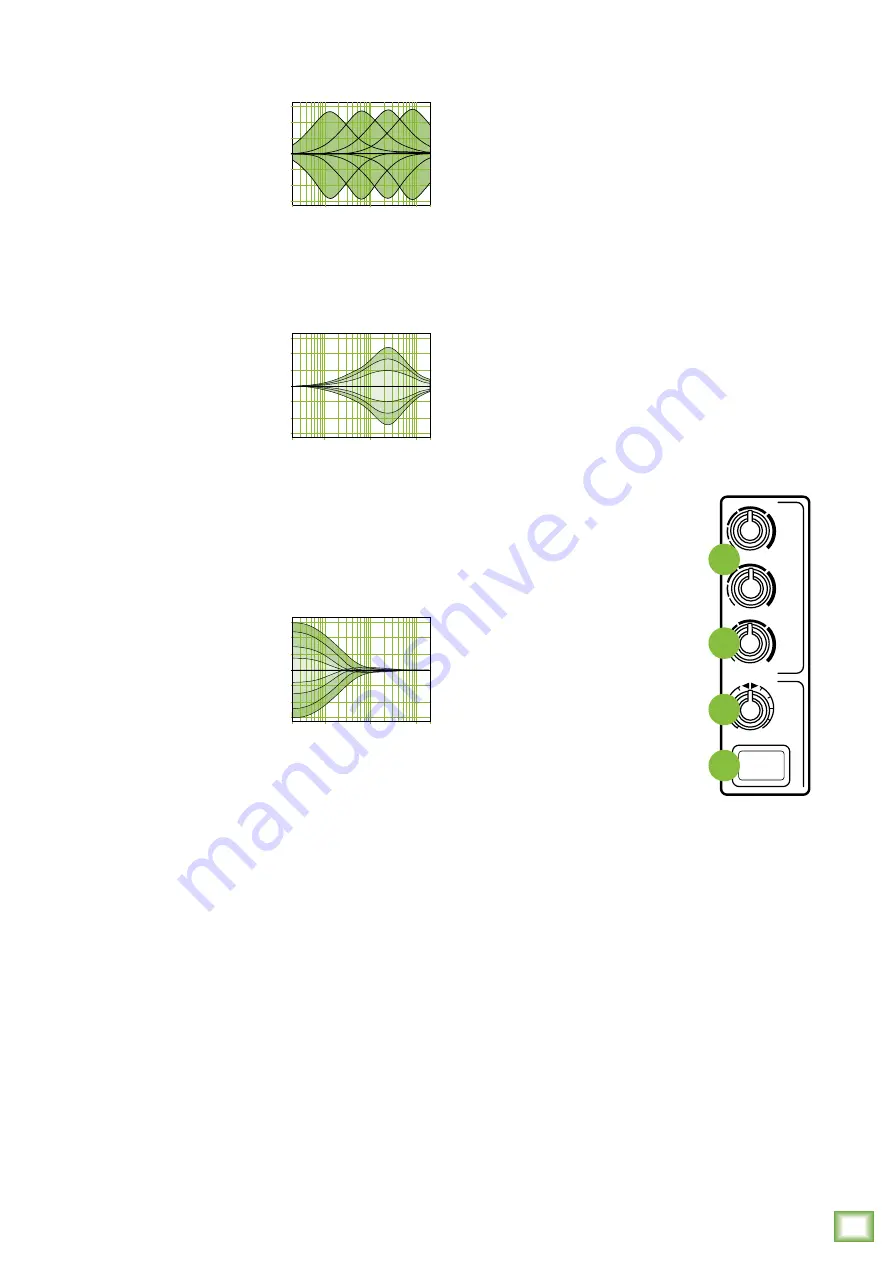
15
Owner
’s Manual
Owner’s Manual
19. Mid EQ Knobs
20. Freq Knobs
Onyx mixers employ
a semi-parametric mid-sweep
EQ. The gain (up to 15 dB
of boost or cut) is set via
the mid EQ, and then “aimed”
at a specific frequency, from
100 Hz to 8 kHz, via the freq
control.
21. Mid EQ Knobs
Short for “midrange,” this
knob provides up to 15 dB
of boost or cut, centered at
2.5 kHz, also flat at the center
detent. Midrange EQ is often
thought of as the most
dynamic, because the
frequencies that define any particular sound
are almost always found in this range. You can
create many interesting and useful EQ changes
by turning this knob down as well as up.
22. Low EQ Knobs
The low EQ provides up
to 15 dB of boost or cut below
80 Hz. The circuit is flat
at the center detent position.
This frequency represents
the punch in bass drums,
bass guitar, fat synth patches,
and some really serious male singers who eat raw beef
for breakfast.
23. Aux Mon Knobs
These knobs tap a portion of each channel's signal
to set up a nice monitor mix feeding stage monitors,
independent of the main mix. Adjust these controls
on each channel until the band is happy with the stage
monitor mix.
The controls are off when fully turned down, deliver
unity gain at the center detent, and can provide up
to 15 dB of gain turned fully up.
The pan and channel fader do not affect the monitor
output, but the other channel controls will. The aux
mon is pre-fader.
The overall output level may be adjusted with the
master mon controls. Internal FX may also be added
to the monitor mix with the FX to mon master knobs.
+15
+5
0
+10
–15
20 Hz
100 Hz
1 kHz
10 k 20 k
–5
–10
+15
+5
0
+10
–15
20 Hz
100 Hz
1 kHz
10 k 20 k
–5
–10
+15
+5
0
+10
–15
20 Hz
100 Hz
1 kHz
10 k 20 k
–5
–10
24. Aux FX Knobs
These knobs tap a portion of each channel’s signal to
set up a nice FX mix feeding the internal FX processor,
and to feed external processors via the FX send.
The controls are off when fully turned down, deliver
unity gain at the center detent, and can provide up
to 15 dB of gain turned fully up.
The mute, channel fader and other channel controls
affect the FX output, but pan does not. The aux FX is
post-fader.
The FX signal reaching the internal FX processor
and the FX send output jack is the sum (mix) of all
the channels whose aux FX control is set to more than
minimum.
The overall output level may be adjusted with the aux
master FX fader. FX are then added to the main mix
when the FX fader's L-R switch is engaged.
25. Pan Knobs
This control allows you to adjust
how much of the channel signal is
sent to the left versus the right
outputs.
The pan control employs a design
called “Constant Loudness.” If you
have a channel panned hard left
(or right) and then pan to the center,
the signal is attenuated about
3 dB to maintain the same apparent
loudness. Otherwise, it would make
the sound appear much louder when
panned center.
26. Mute Switches
Mute switches do just what they sound like they do.
They turn off the signal by “routing” it into oblivion.
Engaging a channel’s mute switch (almost) provides
the same results as turning the fader all the way down
(a pre-aux send is not affected by the channel fader,
but it is by the mute switch).
The channel insert will continue to provide a
signal when a channel is muted. Mute switches
illuminate red when engaged.
PAN
MON 1
MON 2
AUX
OFF
MAX
OFF
MAX
OFF
MAX
L R
FX
MUTE
25
26
23
24
















































